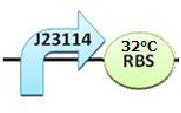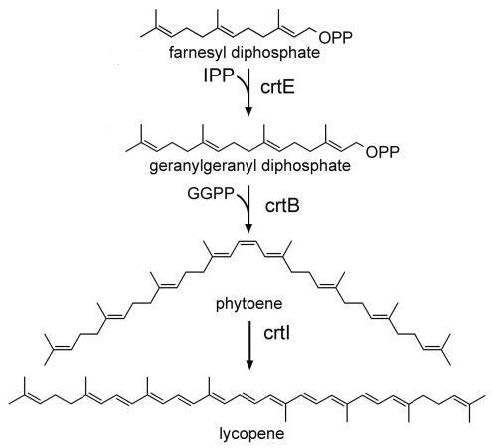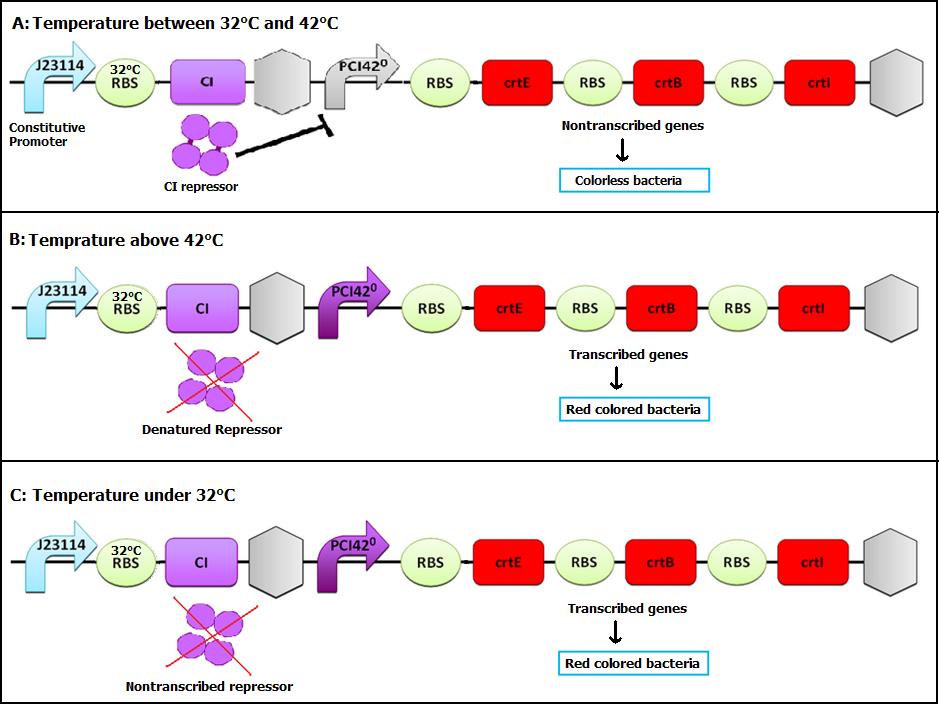Team:Paris-Saclay/Project/Project Description
From 2012.igem.org
Project Description
A repressor is a protein capable of binding DNA to a specific DNA binding site called an operator. The presence of a repressor bound to an operator prevents the access of the RNA polymerase to the adjacent promoter and in turn shuts down the expression of one or several genes that are transcribed from the concerned promoter. This negative regulation is called "repression". The activity of a repressor can be modulated via several mechanisms; for example, a repressor can interact either with an inductor (in this case it detaches from the operator to allow transcription), or with a co-repressor (which binds to and enhances its final fixing to the operator for further decrease of the transcription).
We propose to design a system in which the transcriptional expression of a gene (or of an operon) is repressed within a given temperature range. Such a system could be used to detect whether cells have grown within a defined temperature range. It could also be used to constrain the cell viability within or outside a set temperature range.
To create the above described system, we propose to design a repressor which is present and active only within a temperature interval. How to restrict the activity of a repressor to a defined temperature range? We propose to use i) a RNA thermometer that allows the repressor translation only above a certain temperature (T1) and ii) a thermolabile repressor that would be inactivated above a given temperature (T2). With such a system, the repressor is expected to be active between T1 and T2.
Control by repression: lambda cI
The repressor used for this project is the lambda phage cI repressor. When the lambda phage infects a bacterial cell, 2 outcomes are possible: i) it either produces phage particles and lyses the cell (lysis) or ii) integrates its DNA into the bacterial genome (lysogeny). cI is a protein that repressed the phage lytic function and is expressed during the lysogenic state to prevent the production of phage particles and therefore prevent the host cell lysis. cI forms a dimer in order to act on the promoter “PCI” regulated by cI. If the PCI sequence is adequately inserted within a promoter sequence of a given gene, the later is control of the cI repressor (if present). The repressor in available with the BBa_C0051 biobrick, the PCI sequence is present in BBa_K098995 biobrick.
Expression above a given temperature: RNA thermometer
RNA thermometers are 5’UTR regions of mRNAs that have alternative structures according to the temperature: i) at low temperature, the Shine-Dalgarno sequence (SD) associates by base-pairing to a sequence of its transcript preventing the recruitment of ribosomes and protein synthesis; ii) at higher temperature, the pairing is weakened and ribosomes recognize the SD allowing the protein synthesis (cf. Fig 1). These sequences are present in prokaryotes. They were identified in 1989 [4], however the expression "RNA thermometer" was coined in 1999 to describe the RNA rpoH discovered in E. coli that controls the expression of heat shock genes. Some pathogenic bacteria used RNA thermometers to induce the expression of virulence genes at high temperature within the host as it is the case for Listeria monocytogenes.
Figure 1: The regulation of a gene translation by thermometer RNA.
An RNA thermometer characterised by The TU Delft 2008 team is available via the biobrick BBa_K115017 (Fig. 2) which can be used to allow protein expression only above 32°C.
Figure 2: The biobrick BBa_K115017, composed of an RBS, containing an RNA thermometer, under the control of a constitutive promoter.
For the project, we propose to place the cI repressor under the control of the RNA thermometer of BBa_K115017. As a consequence, the translation of the sequence encoding the cI repressor of phage lambda should take place only above 32°C (T1).
Inactivation above a given temperature: thermosensitive protein
The wild-type lambda cI repressor is efficient at 42°C, however a temperature-sensitive (Ts) cI repressor mutant, called cI857 was isolated and has been widely for temperature-controlled gene expression in bacteria. At low temperatures cI857 retains its wild type property, whereas at nonpermissive temperature (42°C), the repressor is unstable and is not able to bind to the operator of the PCI target promoter (Fig. 3). The Ts repressor which is available via biobrick BBa_K098995 can used to prevent a repressor activity on PCI above 42°C (T2).
The reporter system
Numerous reporters genes can be used to monitor gene expression. We chose a coloured reporter system based on the production of lycopene. Bacteria expressing the lycopene biosynthesis genes have a red color.
Figure 3: The different steps and the enzymes involved in the biosynthesis of lycopene.
The genes crtE, crtB and crtI encode three enzymes involved in the biosynthesis of lycopene that convert the colourless farnesyl pyrophosphate to red lycopene via the intermediates geranylgeranyl pyrophosphate and phytoene (Fig. 3).These enzymes are naturally expressed in tomatoes and carrots .The crtE, crtB and crtI genes has been assembled by the Cambridge team in 2009. They are available via the BioBrick BBa_K274100 (Fig. 4).
Figure 4: BBa_K274100
Experimental system
Biobrick BBa_K274100 is a composite biobrick which contains the lycopene biosynthesis genes (under control of the arabinose promoter); the color red will be the reporter of promoter cI-dependent transcriptions of the four following constructs:
- We propose to substitute the arabinose control by the cI repressor control (part of biobrick BBa_K098995). In the presence of the wild-type cI repressor (from biobrick BBa_C0051), the expression of the lycopene biosynthesis genes is repressed and the bacterial cells will be white regardless of their growth temperatures. This construct tests the efficiency of the repression by cI
- In the second construct, the cI repressor thermolabile (cI(Ts)) from biobrick BBa_K098995 will be used instead of the wild-type repressor. In this case, the repression is lost for temperatures above 42°C (T2) and the bacterial cells should be red.
- In the third construct, the cI open reading frame will be under control of the RNA thermometer of biobrick BBa_K115017 (Pthermo). With this construct, the cI translation will not occur for temperatures below 32°C (T1) and bacterial cells will be red. However, if the bacteria are grown at temperatures above 32°C, the cI repressor is synthesized and active, repressing the lycopene biosynthesis, bacteria will be white.
- Finally, the fourth construct is a combination of biobrick BBa_K115017 and BBa_K098995. The expression of the cI repressor thermolabile cI repressor is dependant of RNA thermometer; with this construct, the repressor is expressed above 32°C but inactivated at 42°C. The cI-controlled lycopene biosynthesis genes will generate red bacteria when grown below 32°C or above 42°C and colorless bacteria between 32°C and 42°C (Fig. 5)
The repressor activity is of the fourth constructs is summarized below:
| Below 32°C | 32°C to 42°C | Above 42°C | |
| cl | + | + | + |
| cl(Ts) | + | + | - |
| Pthermo – cI | - | + | + |
| Pthermo – cI (Ts) | - | + | - |
Figure 5 : The control by the cI repressor of the biosynthetic genes of lycopene.
 "
"








Follow us !